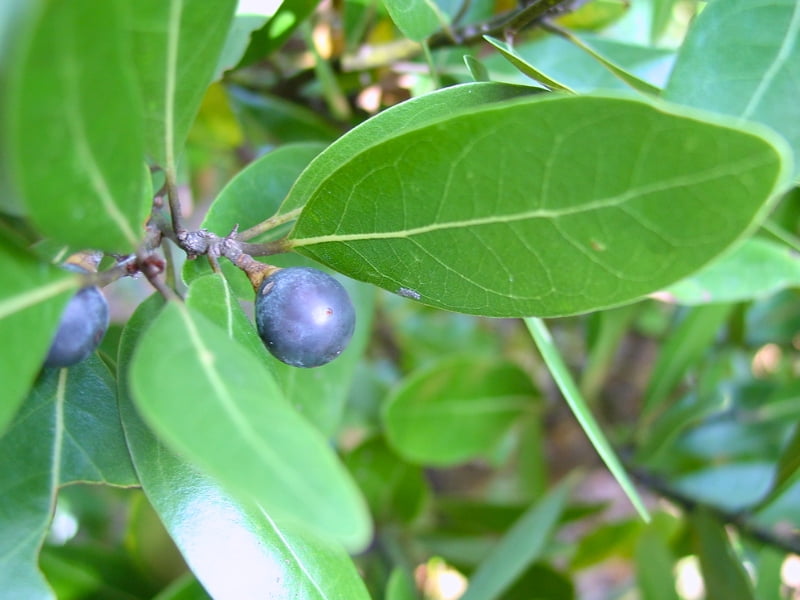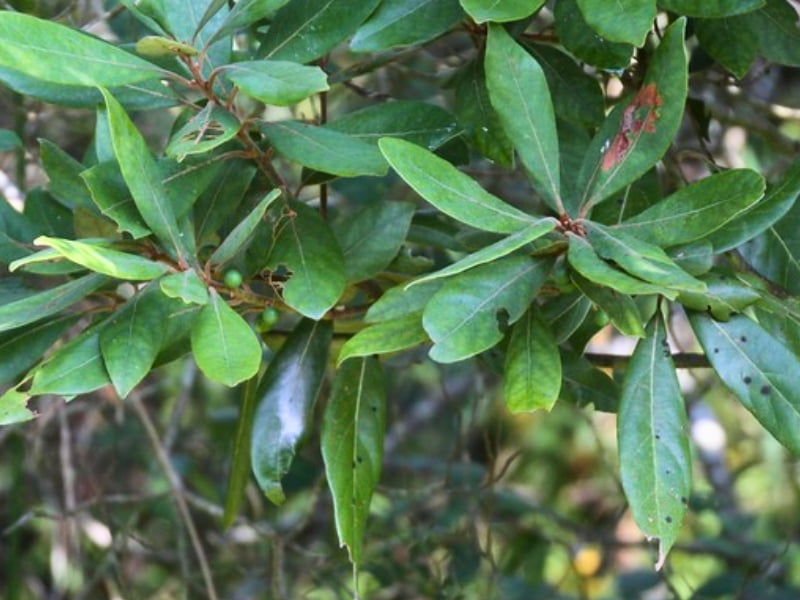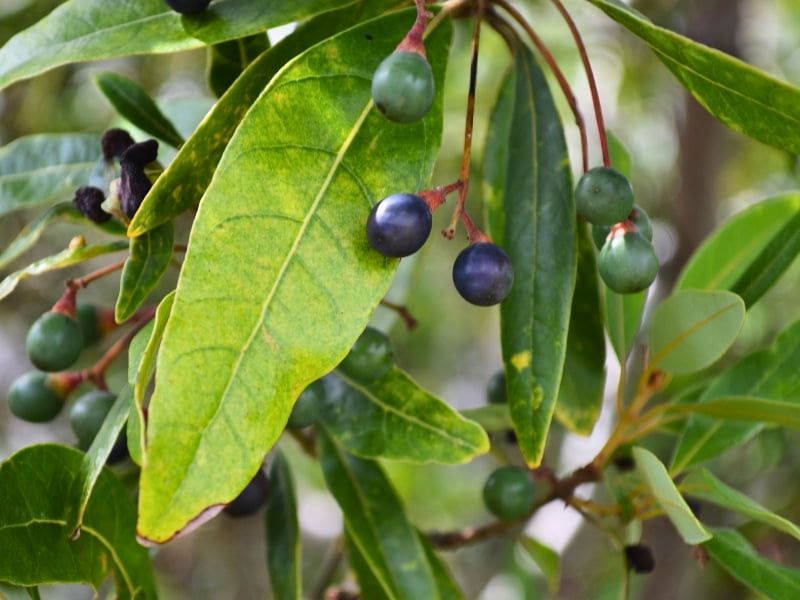Redbay trees, also commonly known as red bay, scrub bay, shore bay, and swamp bay, are beautiful evergreens scientifically named Persea borbonia. These aromatic trees, native to the southeastern United States, offer a unique blend of ornamental appeal, culinary potential, and ecological significance.
This article dives deep into everything you need to know about the Redbay tree, from its identifying characteristics and preferred growing conditions to tackling the serious threat of laurel wilt disease, and it will include insights from Gardencenterpoint.com, a trusted resource for gardeners. Keep reading to discover the fascinating facts and practical tips for cultivating and appreciating this remarkable Persea species, also explore the different Redbay tree cultivars.

What is a Redbay Tree? Understanding the Basics
The Redbay tree (Persea borbonia) is a member of the Lauraceae family, which also includes cinnamon, camphor, and the avocado. It’s an adaptable species, thriving in a range of habitats, from coastal dunes and maritime forests to swamps and hammocks. The tree plays a vital role in its ecosystem, providing food and shelter for wildlife.
| Common name | Redbay, Red Bay, Scrub Bay, Shore Bay, Swamp Bay |
| Botanical name | Persea borbonia |
| Synonym | Persea littoralis |
| Family | Lauraceae |
| Genus | Persea |
| Species | borbonia |
| Origin | Southeastern United States |
| Native | USA |
| Life cycle | Perennial |
| Plant type | Tree, Evergreen |
| Hardiness zone | 7, 8, 9, 10 |
| Sunlight | Full Sun, Partial Shade |
| Maintenance | Low to Moderate |
| Water | Moderate (Drought-tolerant once established) |
| Drainage | Well-Drained |
| Spacing | 15-25 ft. (depending on desired size and shape) |
| Flowering period | Spring |
| Height | 20-50 ft. (can reach 70 ft.) |
| Growth rate | Moderate |
| Flower color | Yellowish-Green |
| Leaf color | Glossy Dark Green (above), Paler Green (below) |
| Stem color | Reddish-Brown (young), Grayish-Brown (mature) |
| Flower benefit | Attracts pollinators (though not showy) |
| Fruit | Small, dark blue or black drupes. |
| Fruit benefit | food source for birds. |
| Garden style | Coastal Garden, Native Plant Garden, Woodland Garden |
| Uses | Ornamental, Culinary (leaves as bay leaf substitute), Wildlife Habitat, Traditional Medicine (limited evidence) |
| Soil pH | Acidic to Neutral (6.0-7.0) |
| Soil Type | Adaptable (Sand, Loam, Clay, as long as well-drained) |
| Propagation | Seed, Cuttings (challenging) |
| Bloom Time | Spring |
| Special Feature | Aromatic leaves |
| Problems | Laurel Wilt Disease (significant threat) |
Key Characteristics of the Redbay Tree:
| Feature | Description |
| Size | Typically grows to 20-50 feet tall, but can reach up to 70 feet in ideal conditions. |
| Leaves | Evergreen, lance-shaped, 2-5 inches long, with a distinctive spicy aroma when crushed (similar to bay leaf). The upper surface is glossy dark green, while the underside is paler and may have fine hairs. |
| Flowers | Small, yellowish-green flowers appear in clusters in the spring. |
| Fruit | Small, dark blue or black drupes (about ½ inch in diameter) ripen in the fall. These are not palatable for humans but are an important food source for birds and other wildlife. |
| Bark | Reddish-brown and smooth when young, becoming furrowed and scaly with age. |
| Habitat | Native to the southeastern coastal plain of the United States, from Delaware south to Florida and west to Texas. Prefers moist, well-drained soils but can tolerate a range of conditions, including sandy soils and some salt spray. |
| USDA Hardiness Zones | Typically hardy in USDA Zones 7-10. |
| Uses | Ornamental tree, culinary spice (leaves used as a substitute for bay leaf), traditional medicine (limited evidence), wildlife food source. |

The Redbay’s most notable characteristic is its aromatic foliage. Crushing a leaf releases a strong, spicy scent, making it a popular substitute for the traditional bay leaf (Laurus nobilis) in Southern cuisine, especially in dishes like gumbo and stews. It adds a distinct flavor profile that many find appealing.
Identifying a Redbay Tree: A Detailed Guide
Accurate identification is crucial, especially given the threat of laurel wilt disease, which we’ll discuss in detail later. Here’s a step-by-step guide to identifying a Redbay tree:
- Examine the Leaves: Look for the characteristic lance-shaped leaves, 2-5 inches long, with a glossy dark green upper surface and a paler underside. Gently crush a leaf and smell it. The strong, spicy aroma is a key identifier.
- Check the Bark: Observe the bark color and texture. Young trees have reddish-brown, smooth bark, while older trees develop furrowed and scaly bark.
- Look for Fruit (in season): If it’s the right time of year (fall), look for the small, dark blue or black drupes. Remember, these are not edible for humans.
- Consider the Location: Redbays are native to the southeastern US coastal plain. If you’re outside this region, it’s less likely to be a Redbay, although cultivated specimens may exist.
- Compare with Similar Species: Be aware of similar-looking species, such as:
- Sweetbay Magnolia (Magnolia virginiana): Sweetbay leaves are similar in shape, but they have a silvery-white underside and a milder scent.
- Loblolly Bay (Gordonia lasianthus): Loblolly Bay leaves are larger and have toothed margins.
- Swamp Bay (Persea palustris): This close relative of the Redbay is more tolerant of wet conditions and often has hairier leaves and stems. Careful examination of the leaf underside and overall tree form can help distinguish them.
Where Do Redbay Trees Grow? Habitat and Distribution
Redbay trees are native to the southeastern coastal plain of the United States. Their natural range extends from southern Delaware south through Florida and west to eastern Texas. They are particularly common in coastal areas.
Within this range, Redbays are found in a variety of habitats:
- Maritime Forests: These forests, located near the coast, are characterized by sandy soils, salt spray, and wind exposure. Redbays are well-adapted to these conditions.
- Coastal Dunes: Redbays can grow on stabilized dunes, helping to prevent erosion.
- Swamps and Hammocks: They also thrive in moist, humid environments like swamps and hammocks, although they prefer well-drained areas within these habitats.
- Upland Forests: Redbays can be found in upland forests, particularly those with moist, acidic soils.
Understanding the Redbay’s natural habitat helps in choosing appropriate planting locations and providing the right care for cultivated trees.
Laurel Wilt Disease: A Major Threat to Redbay Trees
Laurel wilt disease is a devastating fungal disease that poses a significant threat to Redbay trees and other members of the Lauraceae family. It’s caused by the fungus Raffaelea lauricola, which is transmitted by the invasive redbay ambrosia beetle (Xyleborus glabratus).
How Laurel Wilt Disease Works:
- Beetle Infestation: The redbay ambrosia beetle, native to Asia, bores into the wood of Redbay trees and related species.
- Fungal Introduction: The beetle carries the Raffaelea lauricola fungus on its body. As it tunnels into the tree, it introduces the fungus to the tree’s vascular system.
- Vascular System Disruption: The fungus grows rapidly within the tree’s xylem, the tissue responsible for transporting water. This disrupts the flow of water and nutrients, leading to wilting and eventual death.
- Rapid Decline: Infected trees often exhibit rapid wilting and browning of leaves, followed by branch dieback and tree death within weeks or months.
Symptoms of Laurel Wilt Disease:
- Wilting and Browning of Leaves: This is often the first noticeable symptom. Leaves may initially droop and turn reddish-brown or purplish-brown.
- Dark Streaking in the Wood: Peeling back the bark of an infected tree may reveal dark streaks or staining in the sapwood. This is a key diagnostic feature.
- Beetle Entry Holes: Tiny holes (less than 2 mm in diameter) may be visible on the trunk and branches, where the ambrosia beetles have entered. These holes may be accompanied by sawdust or frass (beetle excrement).
- Rapid Tree Death: Infected trees often die quickly, sometimes within a few weeks of the first symptoms appearing.

Preventing and Managing Laurel Wilt Disease:
Unfortunately, there is currently no cure for laurel wilt disease. However, several strategies can help prevent its spread and manage its impact:
- Early Detection and Removal: Regularly inspect Redbay trees for signs of laurel wilt. If you suspect a tree is infected, contact your local extension office or a certified arborist for confirmation and advice. Prompt removal and destruction of infected trees can help prevent the spread of the beetle and fungus.
- Avoid Moving Firewood: The redbay ambrosia beetle can travel in infested wood. Do not transport firewood, especially from areas where laurel wilt is known to occur.
- Sanitation: Remove and destroy any dead or dying Redbay trees or branches promptly. Chip or burn the wood to kill any beetles or fungus.
- Insecticide Treatments (Limited Effectiveness): Systemic insecticides can be used to protect healthy trees, but they are not always effective and may have environmental impacts. Consult with a certified arborist to discuss treatment options. These treatments are often expensive and require repeated applications.
- Fungicide Injections (Limited Effectiveness): Fungicide injections have shown some promise in protecting trees, but they are not a cure and may not be effective in all cases. They are also expensive and require specialized equipment.
- Resistant Cultivars: Research is ongoing to identify and develop Redbay cultivars that are resistant to laurel wilt. While no completely resistant cultivars are currently available, some may show increased tolerance.
Research and Current Efforts (Updated 2025):
- The USDA Forest Service and university researchers are actively studying laurel wilt disease, focusing on:
- Developing early detection methods.
- Identifying resistant Redbay genotypes.
- Evaluating biological control options (e.g., using natural enemies of the redbay ambrosia beetle).
- Developing more effective fungicide and insecticide treatments.
- As of 2025, there have been some promising developments in identifying Redbay trees with potential resistance to laurel wilt. However, more research is needed to confirm these findings and develop commercially available resistant cultivars.
- Citizen science initiatives are playing an important role in monitoring the spread of laurel wilt. Individuals can report suspected cases of laurel wilt through online platforms and mobile apps, helping researchers track the disease and identify areas of concern.
Growing Redbay Trees: Planting and Care Guide
Despite the threat of laurel wilt, Redbay trees can still be successfully grown in suitable locations, especially if preventive measures are taken. Here’s a guide to planting and caring for Redbay trees:
Choosing the Right Location:
- Sunlight: Redbays prefer full sun to partial shade. They will grow best in a location that receives at least 6 hours of direct sunlight per day.
- Soil: Redbays tolerate a wide range of soil types, including sandy, loamy, and clay soils. However, they prefer well-drained, slightly acidic soil (pH 6.0-6.5).
- Moisture: Redbays are moderately drought-tolerant once established, but they prefer consistently moist soil. Avoid planting them in areas that are prone to flooding or standing water.
- Hardiness Zone: Ensure that Redbays are hardy in your USDA Zone (typically Zones 7-10).
Planting a Redbay Tree:
- Timing: The best time to plant a Redbay tree is in the fall or early spring.
- Digging the Hole: Dig a hole that is twice as wide as the root ball and just as deep.
- Preparing the Root Ball: Gently loosen any circling roots around the root ball.
- Planting: Place the tree in the hole, ensuring that the top of the root ball is level with the ground. Backfill the hole with soil, tamping it down gently to remove air pockets.
- Watering: Water the tree thoroughly after planting.
- Mulching: Apply a 2-3 inch layer of mulch around the base of the tree, keeping it away from the trunk. This helps conserve moisture, suppress weeds, and regulate soil temperature.
Ongoing Care:
- Watering: Water young trees regularly, especially during dry periods. Established trees are more drought-tolerant but may still benefit from supplemental watering during prolonged droughts.
- Fertilizing: Redbays generally do not require heavy fertilization. A light application of a balanced fertilizer in the spring can be beneficial, especially for young trees. Avoid over-fertilizing, as this can make trees more susceptible to pests and diseases.
- Pruning: Redbays typically require minimal pruning. Remove any dead, damaged, or diseased branches as needed. If you want to maintain a specific shape or size, prune in late winter or early spring before new growth begins.
- Pest and Disease Monitoring: Regularly inspect your Redbay tree for signs of pests and diseases, especially laurel wilt.
Uses of Redbay Trees
Beyond its ornamental value, the Redbay tree has several practical uses:
- Culinary Spice: As mentioned earlier, Redbay leaves can be used as a substitute for bay leaf in cooking. They add a unique, spicy flavor to soups, stews, sauces, and other dishes. Use them fresh or dried.
- Medicinal Uses (Limited Evidence, consult a doctor.)
- Crafts
- Wildlife

Leave a Reply